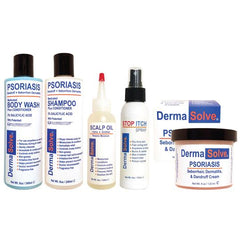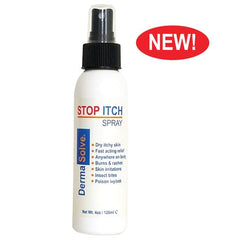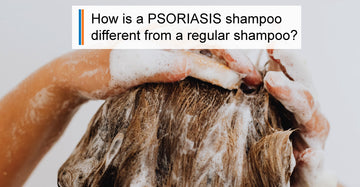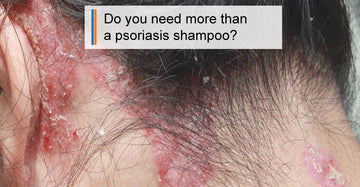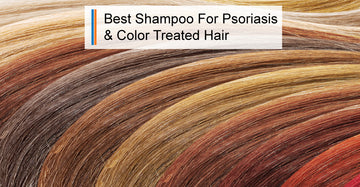The Symptoms and Treatment For Psoriasis
by Michael Marenick on May 11, 2017
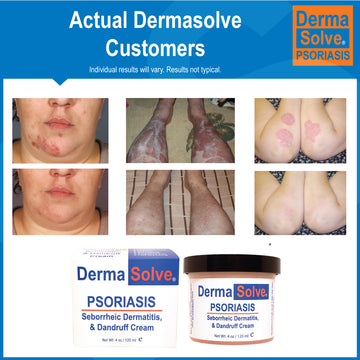
The Symptoms and Treatment For Psoriasis
Learn Where Psoriasis Can Appear on the Body and How to Treat Psoriasis
by: Mike Marenick
Most often, psoriasis will start out as a dry patch that gets worse instead of getting better no matter how much lotion you apply. Typically it starts on the elbows or knees but can actually start anywhere on the body. Before you can determine the right treatment for your psoriasis condition you first need to identify the symptoms and severity of your condition.
A person with psoriasis will generally show signs of raised red patches of skin that will often include thick scaly patches that may have a silver appearance. These areas of skin may also appear to have pustules, depending on the type of psoriasis that the individual has. The actual signs and symptoms will vary with each person but will normally include one of the following:
- Red patches of skin
- Red skin covered with silver like scale
- Itching and Irritation
- Soreness or a burning sensation
- Nails that have ridges or have become thickened
- Dry skin that can be come cracked and bleed
- Swollen and/or stiff joints
Psoriasis can cover only small parts of the body or in severe cases may cover the entire body. Mild cases where individuals have just a slight bit of scaling – much like dandruff will not cause much concern. However, the severe cases can be quite painful and in some cases, may even be disfiguring or disabling.
Many people with psoriasis find that it goes through cycles. It can be bad at times when there is a severe flare up and other times it may go into remission where the disease is barely noticeable. Others have found that the change in seasons can have an effect on their psoriasis. Most of these people will say it is worse in the winter than it is in the summer. Research has shown that psoriasis is lessened when the body produces vitamin D. When we are in the sun, our body naturally produces vitamin D, so it makes perfect sense that summers will be better than winters for this disease.
Other Symptoms of Psoriasis
Symmetry in psoriasis is very common. For example, an individual who gets psoriasis on a knee or elbow will most likely have it on both knees and elbows.
Small red raindrop-shaped patches are associated with Guttate psoriasis. This type of psoriasis is the second most common form and usually follows a strep infection.
People who have psoriasis need to be careful about injuring their skin. Sometimes new patches of psoriasis will develop in injured areas anywhere from 2 days to 2 weeks after the injury. This is often referred to as Koebner’s phenomenon.
Psoriasis on The Body
Face
When psoriasis occurs on the face there are several common locations where it is usually found. It will most often affect areas such as the skin between your upper lip and nose. The upper forehead or hairline is also very common. Some individuals even break out in their eyebrows and around the eyes. When treating psoriasis on the face great care must be taken because the skin on the face is more sensitive than on the rest of our body. In rare cases when psoriasis appears around the mouth and nose it may also appear in the mouth on the gums, tongue or cheek. It can also appear on the inside of the nose and be very uncomfortable.
Elbows & Knees
The most common place where psoriasis is found is on the elbows and knees. Conditions can range from simple itching and redness with some mild flaking, to severe plaque buildup with a silver scale like look. The constant use of our bendable parts can often cause cracking and sometimes bleeding can occur. Having psoriasis on joint areas for longer than 10 years may lead to psoriatic arthritis in some individuals. If you begin to experience pain in your joint areas you should consult with your doctor about the condition.
Hands & Feet
Around 25% of the individuals who suffer with psoriasis have it on their hands and feet. Because we put so much demand on our hands and feet on a daily basis, psoriasis in these areas can be very irritating. Even minor cases of just dry flaky skin can become cracked and bleed. In severe cases the layers of skin may thicken quickly leading to corns and calluses. Typically the skin becomes dry, hard and often reddened. From the constant use of our hands and feet, cracks may begin to appear as the skin thickens.
Body
Psoriasis can be present on all parts of the skin. It is common to find it on the lower back and on the trunk of our body. Individuals who suffer with psoriasis that covers more than 30% of their body should speak with their doctor about treating the disease systemically rather than using topical solutions.
Nails
Psoriasis on the nails is quite common. Usually the nails on the hand are affected more frequently than the feet. Early symptoms may include dryness and redness. If the psoriasis worsens or is left untreated, the nails may eventually have deep ridges and become pitted. The nails may also turn yellowish in color and thicken over time. In severe cases the nails may become very fragile and could fall off.
Genitals
Psoriasis in the genital area does not become thick and scaly like plaque psoriasis. It is most common to find inverse psoriasis in these areas which appears more smooth, dry and very red. Some individuals may have psoriasis on the genitals and nowhere else on the body. Others may have it in addition to psoriasis on the body. It can be minimal such as just small red spots. Or large red patches can form. Since the skin in this area is very sensitive caution should be taken when choosing the correct treatment product for genital psoriasis.
Psoriatic Arthritis
If you begin to have tender, swollen joints or even back pain in addition to your psoriasis, then you may be experiencing psoriatic arthritis. Other symptoms may include general fatigue, stiffness in the morning and a reduced range of motion in the joint areas. Sometimes changes in the nails and redness surrounding the eyes can also be early symptoms of psoriatic arthritis. It is important to catch psoriatic arthritis early because without treatment it is potentially disabling. Whether you have mild or severe psoriasis it is possible for you to develop psoriatic arthritis.
Treatments for Psoriasis That Can Be Found Online or at Your Local Pharmacy
There is no cure for psoriasis at this time. However, there have been some amazing advancements in products to treat psoriasis that can be found at your local pharmacy. The FDA has tested and recommended specific active ingredients that have been proven to treat the symptoms of psoriasis. These ingredients have been formulated into topical creams, shampoos, body washes and even topical scalp oils. Although the active ingredients in many of these products are the same they should not all be considered equal. Some will contain a higher or lower percentage of the active ingredient. Others will contain additional ingredients that are specifically chosen to help moisturize your skin. It is very common for someone to find a product that will remove the dry dead skin cells but will still be left with red patches on their bodies. For the redness to go away your skin needs the proper nourishment to begin functioning normally again. This nourishment can come from supplemental vitamins that are added to the product, herbal extracts or even food based ingredients like eggs. Each over-the-counter psoriasis treatment will have a “Drug Facts” panel that will list the percentage of the active ingredient, it usages and the other ingredients. Be sure to read this carefully so you can distinguish why one product may be different from another. Choosing one treatment for psoriasis over another should not be done based on price but rather on quality.


